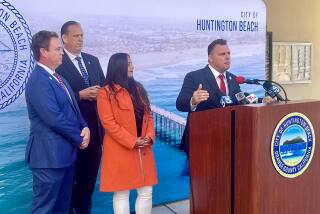A Historic Compromise
The legal agreement reached, appropriately enough, in a hangar at the John Wayne Airport last Tuesday is being hailed by some as a historic compromise that finally resolves the legal battles that have raged over the airport for many years.
It is historic in a sense because it does end the traditional opposition that has come from Newport Beach. The city and two homeowner groups have fought and delayed virtually every major effort made by the county Board of Supervisors to improve the inadequate facilities and service for the millions of passengers that use the airport each year.
And the 20-year agreement, as noted by Board Chairman Thomas F. Riley, who for more than a decade spearheaded a settlement effort, is a true compromise. Everyone involved gave in some areas and got in others. There will be more expansion than opponents wanted, but less than supporters had planned.
But it is no cure-all. Nor does it guarantee peaceful and speedy implementation of plans for a new and larger terminal building, more parking and additional jet flights that will be as quiet on takeoff as technology and compromise can make them.
Although Newport Beach, the Airport Working Group and the organization Stop Polluting Our Newport may have put their lawsuits aside, airport operations and policies are still subject to legal challenge from other cities, residents, airlines and aircraft manufacturing firms.
And with the new legal maximum on the number of passengers that will allowed to use the terminal each year, the pressure to find another airfield to accommodate the county’s commercial aviation needs is even greater.
That, along with one condition of the compromise--in which the county board withdrew its position that there is no suitable site for a new airport in the county--has raised threats of legal action from Irvine. The Irvine City Council is worried about renewed interest in joint civilian-military use of the El Toro Marine Corps Air Station and thinks that it has as good an argument against El Toro as Newport Beach had against more jets at John Wayne.
The county also faces continued legal action from the McDonnell Douglas Corp., American Airlines and possibly other air carriers because the compromise agreement limits the number of daily flights by planes that operate at the noise levels of Douglas’ MD-80. The aircraft manufacturer claims the clause could cost the company sales and result in the loss of jobs for thousands of employees who live in the county and work in the company’s Long Beach plant.
Several years ago when the MD-80 became operational, it had a competitive edge and gained sales because it was less noisy than other aircraft operating at John Wayne. Now quieter jets have been developed by other manufacturers, such as the British Aerospace’s BAe-146 and Boeing’s 737-300, and the advantage has shifted. That’s competition. Although the board may believe McDonnell should concentrate more on developing quieter planes that meet such competition, there is no telling how a judge will rule on the company’s claim that the county’s policy of giving more flights to less noisy jets is discriminatory.
There is no way that the county can operate a commercial jet airport in an area as urbanized as Orange County and still satisfy all interests. Legal threats, lawsuits, negotiations and compromises have been part of the airport’s operation since jet operations were first introduced exactly 18 years ago--on Sept. 1, 1967. We suspect they always will be. But the airport and Newport Beach residents have finally signed a legal truce with terms for a peaceful coexistence. And that can only be viewed as historic progress.
More to Read
Sign up for Essential California
The most important California stories and recommendations in your inbox every morning.
You may occasionally receive promotional content from the Los Angeles Times.










